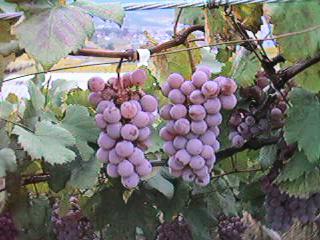English
Welcome to Barriqueville web site !
Japanese Wines
Japan has almost 135 years of history in wine making. 150 years ago, in late Tokugawa Period, rice became so precious as food resource that the regime didn't want to let people make wines (Sake) from rice. Government decided to import technologies and knowledges about grape wines from Europe to replace rice wine. This is how Japan started making grape wines.

Since then, the industry has grown gradually and now there are some good wines that are known by foregin wine critcs. Still very limited information on Japan wines are available for foreigners but there are many eager and amazingly ambitious winemakers in Japan. I will introduce such Japanese winmakers on this page periodically.
Regions
There are two famous wine production regions in Japan. Readers may or may not know more wine regions but most good wines come from these two regions. One is YAMANASHI and the other is NAGANO as you see in the map. Probably NAGANO sounds familier to you all because of the Winter Olympic Game which was held in 1998. YAMANASHI is bigger then NAGANO as wine region as there are neraly 100 wineries are operating among 200 wineries in Japan. Both regions are not very far from metropolitan Tokyo area.
Appellations
There is no regulated appellation system that covers entire Japan although NAGANO has voluntarily introduced appellation system. "YAMANASHI" and "NAGANO" are considered as the largest region's name as they are the names of prefectures or states. And each of them has sub-region or further smaller appellation so to speak. But again, there is no regulation on that. Then, producers can name their wines by their own wish and marketing strategy. Since many producers still use imported grapes for their wine making, when producers only use domestically or locally harvested grape, they want to attach their own invented appellation. No one blames.
Grape Varietals
These days, many wine producers make wines from Chardonnay, Merlot and Cabernet Sauvignon. As the rest of the world, only these grapes seem to make great wines in Japan, too. Of course, producers try other grapes, but as of today, they are not yet successful.
There are several native grape vines in Japan. Among all of them, the most and only notable grape is KOSHU. This is white Vitis Venifera having European origin. KOSHU is ubiquitous in Japan. Almost all wine producers make wines from this grape.

KOSHU
This grape varietal came form Europe to Japan 1200 years ago through Eurasian Continent. Since then, the spieces has mutated itself to adopt Japan's wet and humid climate and soil condition. From the beginning of Meiji Era, 140 years ago, people stated using KOSHU for wine making. Grape growing is tough because of vigorousness of the vine. The vine can't go along with any trellis systems which are normally used for vine growing. Many growers have tried to make it submissive to human kinds! But they have never been successful unfortunately. As a result, a tree is hugely grown and barely trained, contrary to ideal grape vine training. What growers can do is to limit the yield of the grape. Typical wine style is light, low in acidity, sweetish and pear like flavor. 10 years ago, Sometimes KOSHU wine in general has a bit of bitterness, which is also one of characters of the grape. But this bitterness add body to wine rather than give off-taste. Obviously, French wine experts don't like this bitterness though. KOSHU was never considered to produce great wine, but now there are some good KOSHU wines, which are dry, fruity and fresh with firm structure. I will introduce some good ones in the future.
This is for white wine not for red or rose. Skin is thin and the color of the skin is not black enough to make red wine.




